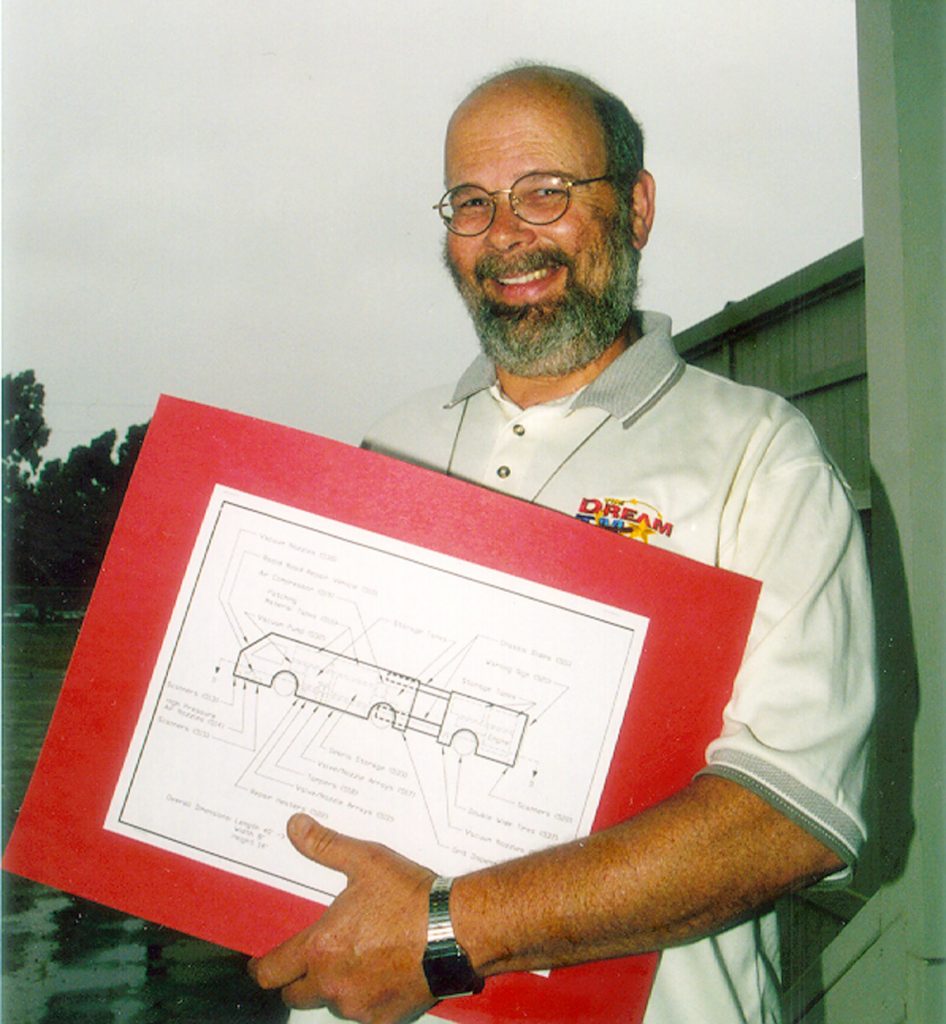
LIVERMORE, Calif. — Leo Mara usually commutes on foot the two miles from his home to work at Sandia National Laboratories. But one day, as he inched along a bumpy road in his van past a repair crew, he dreamed of a bus-sized vehicle that would fix potholes as it drove over them.
That dream is now the laboratory technician’s first patented invention.
Mara’s Rapid Road Repair Vehicle incorporates several aspects of his background. He designs and programs data acquisition and control systems at Sandia, where he has worked 22 years. He previously worked for a trailer manufacturer in Connecticut, his home state, where harsh weather hastens road aging. He said he merged his industrial and high-tech experiences when creating the plan. He also incorporated co-worker Tim Sheppod’s chemical expertise upon adding a rapidly congealing repair mixture to the scheme.
About the size of a Greyhound bus, the vehicle would “see” the road surface from scanners on the front bumper. Any anomalies would be cleaned with high-pressure air and then vacuumed. On-board image processing would distinguish the location and size of road surface features and determine if an object is a hole, bump, manhole cover or crack. Next, a phalanx of nozzles, arrayed like offset rows of theater seats, would pass over. Whichever nozzles were above the hole would deliver filling material, such as aggregate and fast-drying patch material or sealer. The mixture would be tamped into place, dusted with grit to provide traction, and vacuumed. Finally, another row of scanners would check the quality of the repair.
Under ideal conditions, Mara says, “the vehicle could possibly patch roads at up to 35 miles per hour.”
Usually, however, he envisions it moving at 10-15 mph. “Even at 10 miles per hour,” he asks, “can you imagine patching 10 miles of road in an hour? That’s absolutely incredible.”
The automated system would also just require a single operator to turn on the ignition and drive, as opposed to the current practice of using crews to make repairs with time-consuming hand labor. Workers wouldn’t be out on the street exposed to traffic and fumes, he says, and drivers would be less likely to be slowed down around the repair activity, which could also be carried out at night.
Mara envisions that some patching may need to be done differently. But he’s prepared for that — the vehicle carries a global positioning system and cellular phone so a really large hazard can be pin-pointed and called in. The information would also be stored in an on-board data file which could be used to map and analyze road conditions.
In general, he says the beauty of the invention is that it can be used both to fix potholes and as a preventive measure to repair cracks before they grow, sparing expense and inconvenience. “People don’t pay enough attention to cracks today,” he says. “It’s like a stitch in time saves nine.”
The patent, No. 5,746,539, was issued May 5 based on detailed designs that Mara completed on his own time over the last four years. Sandia assisted patenting the invention and is looking for a commercial partner to develop a working prototype and to commercialize the invention under a license.
The need for automated road repair seems particularly relevant in the wake of El Niño’s heavy rains, which have sent transportation agencies scurrying to improve road conditions. Either state or federal agencies might be good initial customers for the automated system. Ultimately, Mara says, the rapid road repair vehicle “would be a piece of equipment that most any town could afford to buy. It wouldn’t be that expensive,” perhaps $300,000 to $325,000.
Sandia’s Licensing Manager Subra Subramanian estimates the potential market for such a vehicle could be $200-500 million in the United States alone.
Says Mara, “I’d like to see the thing built and rolling down the road — and after it rolls down the road, the road’s fixed. That’d be really neat.”
Licensing Contact:
Subra Subramanian, cvsubra@sandia.gov, (925) 294-2311